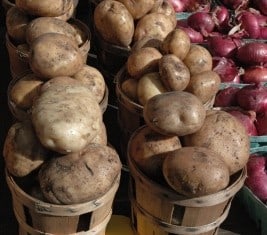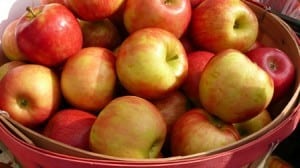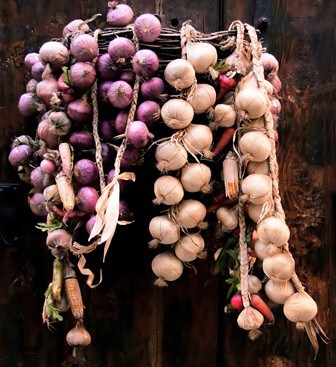Before electricity, people relied on root cellars. Even my grandparents, with a refrigerator, used a root cellar. My cousins and I called it the “scary cold room”. They grew their own food or bought what they could to preserve and store for the future.
This was especially important in areas with harsh winters where seasonal produce was hard to come by. In more modern times, many homes still have root cellars.
Sometimes people moving to rural areas want to create one as a way of getting back to the basics. It is a way to use the land, reduce electric bills, while creating a system for food security.
Take a walk around your home, barn, and property. Think about creative ways to find existing root cellar options or locations for construction or burying.
Be on the lookout for large containers that might be suitable for burying or embedding. The possibilities are endless. I have some ideas below.
Root Cellar Basics
Setting up a root cellar on your property will help you store root vegetables, fruits, and canned goods. This practice dates back centuries, originating before homes had refrigerators. Root cellars stored the bounty from spring through fall harvests so when the cold months set in, people would have access to these foods.
In some climates, root vegetables can successfully overwinter in the garden if well-mulched before the first freeze. However, frozen ground or harsh winters may prevent harvest until spring. As long as they haven’t been devoured or damaged by rodents, these vegetables will usually still be edible.
But for storage of other produce, root cellars can be a vital part of a family’s food preservation system.
Getting Started
Root cellars are locations with fairly stable temperature and humidity where you can store fruits, vegetables, and other foods for several months.
While root vegetables—like carrots, turnips, and parsnips—are among the best keepers, many other types of produce can be stored in root cellars for anywhere from a few weeks to several months. As long as they are prevented from freezing, jars of home canned goods will also keep well in a root cellar.
On most properties, there’s likely a place where someone could set up a root cellar. The key is to find a spot that will not freeze or become too hot, is neither bone dry nor wet, and gets some ventilation.
Some locations provide suitable conditions for all produce to keep well, while others are good for specific types. These locations vary from a dugout in a hillside to an insulated space in a garage.
Storing Different Types of Produce
- Root vegetables and tubers like potatoes, carrots, turnips, parsnips, and onions prefer cool and damp conditions.
- Garlic and onions do best in cool and dry environments.
- Pumpkins and squash need a dry spot that’s not too cold.
Many people store various items in multiple locations to create the ideal environment for each type of produce. Others find a “happy medium” location that works for most items.
With a large root cellar, it is possible to create different microclimates in each corner, allowing for the storage of a diverse range of produce.
Root Cellar Ideas
You may want to start with a smaller, more manageable root cellar and then expand later if you are using it a lot.
Plastic storage bin, trash can, or barrel buried in the ground:
This is an extremely low-cost option for very small-scale storage. It’s suitable for storing small quantities of produce for a short period. However, it’s less reliable in terms of temperature and humidity control compared to other methods.
Hole dug in the ground outdoors or in basement or garage:
This is a more common and cost-effective method for larger-scale storage. It offers better temperature and humidity control compared to buried bins/barrels, but it still requires careful attention to drainage and insulation to prevent moisture and temperature fluctuations.
Corner of cool basement, framed in or not:
You can potentially frame them in for better organization and temperature control. Consider also an unheated closet, room, or enclosed porch.
Cave dug into a hill or bank:
Provides natural insulation and drainage but may require professional assistance for construct it safely.
Stacked hay or straw bales forming sides and top of a box shape:
Straw bales provide good insulation and sustainability but you need to maintain regularly to prevent moisture damage and to ensure there’s ventilation. You also need to set up good drainage.
Use an old fridge or freezer:
Upcycling an old appliance can be a budget-friendly option. Remember to ensure proper drainage and ventilation to prevent moisture buildup and rust.
I’ve even seen photos of an old bus partly buried in a hillside, with the front door exposed for easy access. Now that’s creative repurposing!
Crawlspace under house:
If your crawlspace is tall enough and has decent moisture control, you can convert it into a root cellar with proper ventilation and insulation.
Insulated shed or barn:
Convert existing sheds or barns into root cellars with proper insulation, ventilation, and temperature control measures.
Equipment You Need
Little equipment is required in a root cellar, but there are a few nice-to-have items, depending on the type:
- Baskets, boxes, or crates: To organize and store produce
- Wood pallets: Raise containers off the ground to improve air circulation and prevent
- Temperature/humidity gauge: Monitor the environment and ensure optimal conditions for your stored produce
- Pipes or tubes for ventilation
- Wall or overhead racks and hooks for hanging mesh bags of produce, garlic and onion braids
- Sand and straw for insulating in and around containers and separating layers of produce
- Lights and fans, if electricity is available

Planning and Construction
Be sure to research your local building codes and regulations before construction. It’s also a good idea to consult with experienced builders or professionals for guidance if you are considering a more complex root cellar.
Find the right location:
The key to a successful root cellar is choosing a location with consistent temperatures and humidity.
- Basements: Cool, underground basements often provide the perfect environment.
- Hillsides: Consider digging into a well-drained hillside for natural insulation and drainage.
- Outdoors: In some climates, well-insulated and buried structures can work outdoors, but ensure proper construction to prevent freezing and moisture damage.
Important to consider:
- Temperature: Aim for a consistent temperature between 32 – 40°F (0 – 4°C) to prevent freezing and spoilage.
- Humidity: Maintain moderate to high humidity (60 – 80%) to prevent produce from drying out.
- Ventilation: Ensure proper air circulation to prevent moisture buildup and mold growth. Consult with a professional if needed to establish an appropriate ventilation system.
Common root cellar materials:
Materials should have good insulating properties and be resistant to moisture.
- Walls: Stone, concrete, brick, wood, or even rammed earth can be suitable options.
- Flooring: Natural materials like dirt or sand for breathability; depending on your location and construction method, you might need a vapor barrier to prevent moisture from rising from the ground.
- Insulation: Straw bales, wood shavings, or even soil can provide effective insulation.
- Doors and ventilation: Choose airtight, insulated doors and incorporate ventilation systems (refer to a professional for appropriate design) to regulate temperature and humidity.
The root cellar walls, floor, and ceiling can be made of almost any material. Finished interiors are nice, but dirt, concrete, bricks, blocks, stone, and straw bales will do the job. Sand can be used for flooring. Some containers, such as refrigerators and barrels, are completely lined.

Benefits of Root Cellars
Reduced food waste: Extend the lifespan of your harvest, minimizing waste and maximizing your food resources.
Cost savings: Reduce reliance on store-bought produce during off-seasons, potentially saving money on groceries.
Fresher taste: Enjoy the superior flavor and quality of homegrown or locally sourced produce stored at its peak.
Energy efficiency: Utilize natural temperature regulation, minimizing dependence on electricity-powered refrigeration.
Self-sufficiency: Promote self-reliance and food security by preserving your own food supply. Storing food may enable to you extend your trips to the grocery store.
Related content:
- Home Canning Guide: Tips to Keep Your Food Safe
- Path to Sustainability is Preserving Fresh Food


I just recently heard of someone who buried an old chest freezer, then put wire shelving in to use it as a root cellar. I thought it was the coolest idea!
Lisa, that is clever–it’s amazing what people can come up with! I really think there’s a way to make a root cellar anywhere. Plus I’m all for repurposing and finding new uses for things that no longer do what they were made to do.
Marie
Awesome information — we have a root cellar under our porch with a hatch lid and store our potatoes there.
Thank you for sharing at Rural Thursdays this week!
Nancy–your root cellar sounds interesting! It’s a great use of otherwise unused space. Is the container buried under the porch or above ground? Thanks for welcoming us to Rural Thursdays!
I have an old fridge and am thinking of burying it and using it to store potatoes and possibly pears. Does anyone know do I need to vent it by cutting a hole in door and running a piece of PVC through it and screening it off for bugs?